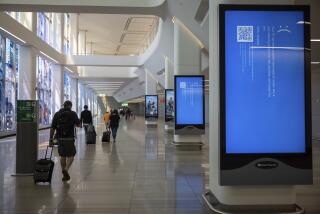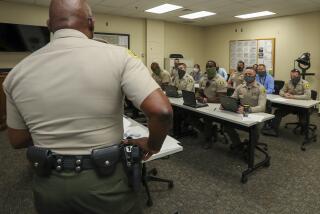Diagnosing Data Disease : Tustin Firm Fixes Manufacturing Process After a Computer Virus Is Discovered
- Share via
The headline in the Hendersonville Citizen News, a tiny weekly outside Nashville, Tenn., said it all: “Virus Attacks Newsroom Computer at Citizen News!”
Sounds bad enough, but it was actually worse. The paper published its first edition Oct. 6, after weeks of grappling with a desktop publishing system that constantly crashed, gobbling up everything from stories and advertising to the very masthead that proclaimed the paper’s name.
“For a week to 10 days, we didn’t realize it was a virus,” said Nick Rapheal, publisher of the Citizen. “We just assumed that, because we were new to the Apple Macintosh, that this was something we were doing. We don’t have a lot of software, so it didn’t take long for the virus to cripple it.”
After calling in professional help, Rapheal said, the virus was traced to two hard disk drives manufactured by CMS Enhancements Inc. of Tustin, products that arrived in the newsroom untouched in their packaging.
Jim Farooquee, CMS president, denies that his firm caused the Citizen’s copy to turn into what Rapheal called “electronic confetti.” But he did say that three or four CMS customers contracted computer viruses in early autumn and that the problems were “corrected within that time frame.”
“There was a problem 4 months ago,” Farooquee said. “We have not been able to establish the fact that the problem started from us or came from us.”
Nonetheless, CMS is giving customers software to correct the problem and has revamped its manufacturing process to protect against infection.
A virus sneaks into a computer and takes over, making countless copies of itself so that it can infect other computers. Like its biological counterparts, it may lie dormant for long periods of time. It may also cause the computer to flash a message to its user that the system is infected. Others simply go on data search-and-destroy missions.
The virus that hit Hendersonville apparently did both.
“When the message first came across the screen stating that my computer might have a virus, I thought it was rather humorous, but I had no idea how serious the problem would become,” Rapheal wrote in his Oct. 20 edition. Eventually, the virus “had copied itself onto the data disks, scrambling the contents and turning stories and advertisements into electronic confetti.”
The infection soon spread to most of the computer’s software, “making it useless,” Rapheal wrote. Since October, the Citizen has pretty much eradicated the virus, although an occasional glitch pops up as an ominous reminder that spores may still be lurking in the system.
John L. Sands, CD-ROM technical operations manager at Nimbus Records USA in Charlottesville, Va., said his company caught the virus from a CMS hard disk drive as recently as December.
A CD-ROM is a compact disk that contains computer data rather than music. Quantum Leap Technologies, a Coral Gables, Fla., software firm, had contracted with Nimbus to press a CD-ROM packed with free software for Apple Macintosh users.
Quantum had checked all of the software and found it virus free before it was sent on to Nimbus, said Robert Burr, Quantum’s president. Nimbus pressed an order of the CDs, and Quantum had distributed 450 before the problems sprang up.
“During the time we made the CD-ROM, we had hard disk drive failure,” Sands said. “Computerland, where we bought it, took it back and changed the drive or reformatted it with CMS equipment and infected it.”
Nimbus used the infected disk drive to press the compact disk filled with Apple software and infected the disk. The disk passed the virus to the computer users who bought it, Sands said.
So he called CMS. Sands recalled that a company spokesman told him that he could get a computer vaccine program for free and that CMS was “aware of the problem and we’ve corrected it.”
Farooquee said all CMS customers can call the firm and receive the virus-bashing software for free. In addition, other virus-fighters and vaccines are available in the public domain via computer bulletin boards.
In addition to creating a software solution to the virus, CMS also has altered the manufacturing process for its hard disk drives since the virus showed up 4 months ago, Farooquee said.
“We have preventive measures that have at least six different checkpoints that check and verify, making sure that there is no virus or any type of not-needed program,” Farooquee said. “It’s almost impossible now, very difficult, to have a product coming out of us having a virus.”
For the Hendersonville Citizen, the virus was a rocky welcome to the world of electronic illness. Though the most notorious computer infections have plagued university and government systems, businesses are now learning that they are not immune to the problems.
Most business computer systems are basically isolated and come in contact with other computers only through borrowed software and electronic bulletin boards. In contrast, many government and university systems are linked into electronic research networks that increase the chance of outside interference.
Businesses “are very vulnerable every time they take in a piece of software from the outside, even if it’s an official vendor product . . . in the ‘shrink-wrapped package,’ ” says Peter G. Neumann, a computer scientist at SRI International, a research and development firm in Menlo Park.
Neumann said that viruses of all sorts can happen in a wide variety of ways and that there is no way to guarantee that computer software or equipment is free of bugs.
There are computer entrepreneurs who make their living selling antiviral software, which can be helpful if a business owner is looking for a particular virus. If, however, that business owner is looking for some unknown contaminative form, Neumann said, the software may not be much good.
But you can safeguard your system. First, he said, it’s important to realize that just because a small business is isolated from large computer networks, it is not immune.
“Have trustworthy programmers,” Neumann warns. “Rely on them. Don’t copy software from unknown sources. Run a computer system that is not absolutely wide open to all kinds of attacks. There’s a long list of things to do to make it a little bit better. Each will make it only a little bit better. There is no easy answer.”







